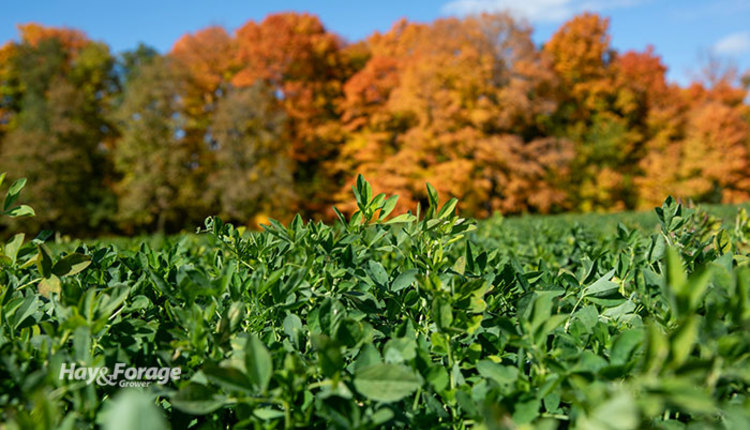
Whether you are adjusting soil pH for a new alfalfa seeding, adding maintenance fertilizer to a mixed stand, or giving an old pasture a boost of nutrients, getting a soil test is probably on the to-do list for completing that task. By quantifying soil fertility and its chemical, physical, and biological properties, soil tests can help guide input applications in hayfields and pastures.
Despite the useful information a soil test provides, its accuracy will reflect the precision in which soil samples were taken. Variability within fields — even between a few acres — must be accounted for, and the sampling depth needs to align with testing protocols. Depending on the soil testing lab, a 6- to 8-inch sampling depth is usually recommended to measure parameters like soil pH, organic matter, phosphorus, and potassium, whereas nutrients such as nitrogen and sulfur require samples be taken at least 2 feet deep.
Another factor for a well-rounded analysis is the number of soil cores that are combined to make a composite sample. Just like a subsample from one bale isn’t enough for a hay test, a single core won’t suffice for a soil test. In fact, the more soil cores included in a composite sample, the more accurate your results will be. And these cores must be taken from the same sampling depth.
While it is possible to test soil on either shoulder of the growing season, doing so in the fall has several advantages over the spring. Perhaps the biggest benefit is that fall soil testing gives producers more time to create a fertility program for the upcoming year, thus allowing them more flexibility in making fertilizer applications. It is also ideal to test soil and apply lime in the fall so it can take effect before the next growing season begins.
Timing fall soil sampling can be challenging as the concentration and availability of several nutrients fluctuate with temperature and moisture. For example, extension specialists with South Dakota State University explain that potassium levels will be lower after a dry spell if the nutrient becomes trapped in shrunken clay molecules. They also suggest waiting until soil temperatures are 50°F or lower since nitrogen and sulfur are released to the atmosphere in warmer conditions; however, soil samples should be collected before the ground freezes.
Above all, consistency is key in the sampling process, especially if test results are compared over time. Soil testing is typically recommended every three to four years, but testing soil more often may help prevent excess fertilization or nutrient deficiencies.
So, how can you make the most of your fall soil test?
First, know what you will use the test for; your goals will guide your sampling specifications. Then acquire the necessary tools and assess your fields to designate sampling sites. Be sure to take plenty of subsamples at each site for more comprehensive data, and work with your local extension agent or crop consultant to submit your samples to a lab for analysis.
Use a soil probe. Dorivar Ruiz Diaz, a nutrient management specialist with Kansas State University, says soil probes ensure the most accurate soil samples, and these tools can be borrowed from most county extension offices. Shovels or spades — especially those that come to a point — can skew data by pulling a soil sample that has more material from the surface and less material from lower depths.
Define sampling sites. Identify variations in a field and separate sampling sites according to soil properties and previous farming practices. Diaz notes sampling sites can be anywhere from 10 to 40 acres as long as soil conditions are relatively uniform across the area. Otherwise, use distinctions like soil texture, water drainage, and cropping history to define smaller areas that will yield more representative soil samples.
Take several soil cores. Diaz recommends taking 15 to 20 soil cores from each sampling site; however, 20 to 30 samples will provide more accurate results. Walk across the site in a zigzag pattern while collecting samples rather than following straight lines to minimize the effects prior fertilization or tillage can have on the integrity of the soil. Then mix subsamples together in a clean container. Follow your local state recommendations for sampling intensity guidelines.
Consider precision soil testing. Grid or zone sampling may be more effective in fields where soil properties and/or previous farming practices create large variations in soil fertility and nutrient availability. These sampling methods are also necessary to develop variable rate fertilizer application plans.
For grid sampling, divide a field into 1- to 2.5-acre squares. Collect multiple subsamples around the center point of a section to create a composite sample. Do this in each square. Grid sampling is recommended every four to five years to maximize its cost-efficiency, so it is not the preferred way to test residual nitrate levels, which can change from year to year.
For zone sampling, utilize mapping data to divide a field into sections with similar characteristics. Look at map layers that show soil series, topography, and forage yields, and consider stand health to determine zone boundaries. Then take 15 to 20 subsamples within a zone and combine them for a composite sample. Repeat these steps in every zone.
Soil specialists with the University of Nebraska Extension note zones don’t have to be contiguous if similar soil conditions exist in two different locations of a hayfield or pasture. In this case, take subsamples from each part of the noncontiguous zone and combine them into one composite sample that represents all the different locations.

